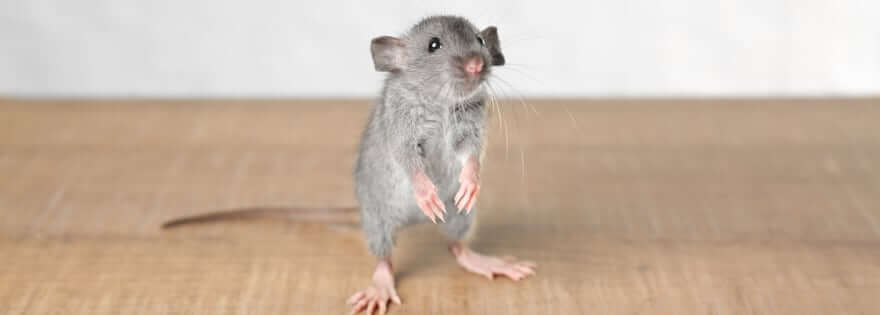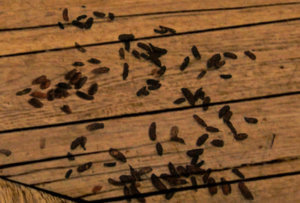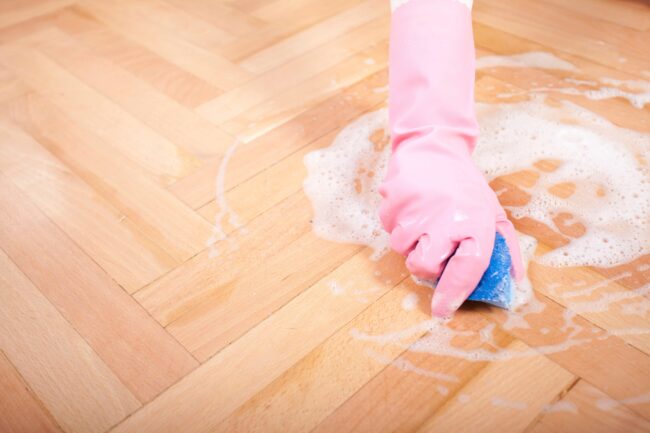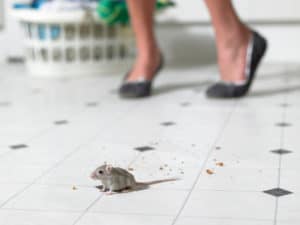How to Identify Mouse Droppings
By: EarthKind
Seeing a mouse in the house is upsetting, but finding out that a rodent infestation has been lurking in your home for a long time is even worse. Knowing how to identify the signs of a pest problem will help you prevent infestations and keep your home pest-free.
Finding mouse droppings or “mice rice” is one of the most obvious signs that you have a rodent problem in your home. Being able to identify whether droppings are from a rodent or a different type of pest will help in creating a plan to clean up the droppings and get rid of the pests.
Mice can be dangerous. Whether you have a small problem or a full blown mouse infestation, it’s important to act fast. There are many diseases that can be spread through mouse feces — from salmonella to Hantavirus — so cleaning affected areas is especially important. They can also trigger allergies, which can lead to sneezing, coughing, and more. We discuss what mouse poop looks like, the dangers of having droppings in your home, and what to do once you discover the issue.
What Does Mouse Poop Look Like?
Mouse droppings look similar to dark grains of rice, ranging in size from 3/16 of an inch to ¼ inch long. The pieces typically have pointed ends and vary from blackish brown to gray in color, depending on how long the droppings have been laying there and the diet of the mouse.
Fresh droppings are black. They turn brown over the next week and change to gray over time. If a rodent has consumed pesticide from a bait station, the droppings may be the same color as the bait. Older droppings will crumble upon contact, while fresh ones will be soft and malleable (never touch any of them with your bare hands).
Mice can leave behind 50-75 pellets per day. The number and size of droppings you see can help you determine the severity and type of pest problem you are facing. These critters will poop while they are moving, so droppings will be seen along the paths they travel and in the places where they are finding food. They may poop near their nest, but they will not go to the bathroom in their actual nest — believe it or not, they like to keep their homes clean!
Does it Smell?
While rodent droppings may not have any noticeable smell, mouse urine has a distinct ammonia smell. These pests have very poor eyesight but a highly developed sense of smell. They can gather information about an area from the scents left behind from other rodents’ waste, such as where to find food and what areas to avoid.
While you may not be able to find their droppings by smell, you may notice an ammonia smell from the urine they leave behind. If you can clearly detect this scent, it’s likely that there isn’t just a single mouse but many within the home.
Keep your home pest free with simple, effective solutions. Subscribe and save!
What Does Rat Poop Look Like?
Rat poop is generally the same shape as mouse poop with pointed, tapered ends and a similar black/dark brown color, but they are larger. They are usually about a ½ inch in size, so that’s the best way to differentiate which type of rodent may be in your home.
House mice, deer mice, roof rats, and Norway rats are typically to blame for rodent infestations in a home.
Other pest droppings, like cockroach or termite droppings, are sometimes mistaken for rodent droppings because of their small size and dark color. Squirrel droppings are similar in shape to that of a rodent, though a little larger and thicker. Raccoon poop is more similar in appearance to a small dog’s poop.
If you think you may have a problem with a different type of pest, take a look at our pest dropping identification chart.
How to Clean Up Droppings
After you’ve identified rodent droppings, you need to get rid of them immediately due to potential health risks. They are not just unsightly but can also spread disease. You must follow safety precautions when cleaning up mouse droppings. Take this advice from the CDC:
- Air out the space for 30 minutes before cleaning, if possible.
- Wear rubber, latex, or vinyl gloves and a mask or respirator.
- Use a disinfectant spray (DIY by mixing 1 part bleach to 10 parts water) and soak the area for 5 minutes.
- Clean the area with disposable rags or paper towels.
- Put waste in a sealed plastic bag in a covered trash can.
It is especially important to avoid sweeping or vacuuming areas where mice have been until after these steps have been completed. Sweeping or vacuuming can cause germs to circulate in the air; if you inhale any pathogens from rodents, you could become seriously ill.
Common Places You May Find Rodent Droppings
Rodents are always seeking shelter, food, and warmth, so mouse and rat feces are typically found in areas where these pests frequent. Kitchens, cabinets, pantries, closet spaces, attics, basements, garages, and food storage areas are common areas where droppings may be found.
Additionally, check behind appliances, around water heaters, in wall voids, and along baseboards, as mice tend to navigate along these paths. Secluded areas and spaces full of potential nesting materials such as insulation or cardboard boxes are also places to look. Observing and cleaning these areas regularly can help identify and address potential infestations promptly.
Preventive Measures
Cleaning up after these pests is not an activity you want to repeat, so take your time to inspect the areas you found droppings for potential entry points they may use to come inside. They can enter through an opening smaller than a dime and easily chew through foam insulation, wood, and plastic. If you notice any cracks around doors, kitchen cabinets, window frames, or open spaces where pipes, cables, and utility lines pass through the wall, block the openings with steel wool. Use silicone caulk to fill in cracks and gaps.
Make the area less attractive to household pests by cleaning up any available food sources, such as dirty dishes, uncovered trash cans, or unattended pet food. Clear clutter so mice have fewer places to hide, and consider using a rodent repellent to prevent this from happening again.
Stay Away Rodent is a botanical rodent repellent that works to get rid of mice and prevent them from coming back in the future. Shop Stay Away Rodent online or in a store near you.












Hi,
I was just wondering, do you ever find just one dropping? We had a mouse problem about 8 months ago that was taken care of by an exterminator. But I was taking the cushions off of the couch yesterday and discovered a cushion had been gnawed a little bit. Upon further inspection, I found a singe mouse/rat dropping underneath the mattress of the pull-out part of the couch. It was black, but rock hard. Do you think it could be from the previous problem? We haven’t had any other signs, and I have no idea how it would have gotten in without leaving a trail of droppings. I’m freaking out!
Thanks for your help!
Hello Megan,
Finding just one dropping is unusual. If it is in fact a mouse dropping and it was hard, it must have been at least a few days old. This could possibly be left behind from the previous infestation, but it’s hard to say. Start by taking the time to make sure you’ve blocked off potential entry points, sealed up and properly stored any food that may attract pests, and when in doubt, pouch it up. Using some Fresh Cab or Stay Away Mice in those hard to reach areas may give you some peace of mind.
If you’re still feeling uneasy, feel free to share photos with us on social media (just be sure to tag us @earthkindinc) or consult a local Pest Control Pro.
Good luck, and thanks for reading!
Hi,
I keep finding white round spots on the floor of our kitchen! Even though I mop. They seem to be increasing in frequency.
Is this rodent wee?!
How can I post a picture so you can check?
Thanks in advance!
Hello Laura,
Thank you for reaching out! We would love to see photos, but identification can be difficult due to a variety of factors.
Mice urine has a distinct ammonia smell, this may help you distinguish if it is or not. You can also shine a black-light on the area; if it glows then you will know it is urine!
We recommend to read the CDC guidelines for cleaning up after rodents Cleaning Up After Rodents to prevent risk of disease. It is best not to use the same mop to clean other areas. Use gloves, and disinfectant solution (or bleach).
If you do find that you are having problems with mice, we recommend Fresh Cab which has protected farms and families Since 1995. You might also try Stay Away Mice, which is an alternative with a lighter scent– perfect for use in your living spaces.
Thank you for reading!
my infant daughter picked one of those and put it in her mouth , my wife rushed immediately and removed it and cleaned her mouth ,
what should we do
Hello Abbas,
Thank you for your inquiry. We are so sorry to hear. That must have been scary for both of you. Glad to hear that your wife was able to react quickly to remove the dropping. We recommend contacting your pediatrician immediately for more information. They will be able to provide the correct guidance. In the meantime continue monitoring your daughter for obvious health changes (i.e. fever, diarrea, skin changes, etc.). Some health insurance cards have a nurse line on the back of the card. Your closest urgent care unit or emergency room may have an emergency line as well. Please keep us posted. We are here to help. You may contact us at [email protected]
Thanks for reading!
I found old droppings in two drawers in a cabinet. There were a lot in the top drawer and a few in a bottom drawer, I can’t find any more any where. There is no chewed boxes in the pantry, there are no droppings around the kitchen, there was a random dropping in the lower section of the cabinet below the two drawers, but I took a good look around and couldn’t find anything else. We don’t hear anything like squeaks or scurrying. Should I be worried or is this like a freak incident?
Hi Laura,
Hopefully since the droppings were old, the mice have moved on to a more suitable location — like outdoors! You’ve done a good job looking and listening for other clues. However, mice leave scent trails to let their friends and family know if they’ve found a safe place to build a winter home or a reliable food source. I would suggest you review the CDC guidelines for cleaning up after mice, and then place a few pouches of our botanical rodent repellent in the areas where you’ve seen droppings or signs of mice just to make sure you don’t have any uninvited house-guests.
Thanks for reading!
I have had mouse problems in the past, and most recently i have had one mouse in my bedroom. I caught that one in a trap and the next night before i could start cleaning (i had been very busy the day after the first mouse died) i saw a second one running around. Every single mouse i’ve seen in my house are deer mice, which is scary for hantavirus reasons. Its easy to tell a deer mouse by the white bellies they have. Anyway, this latest mouse running about in my bedroom is completely ignoring the traps i have set up, which is strange because i thought mice liked peanut butter. I know you don’t recommend the peanut butter traps but they have caught the mice in the past. This one however completely ignores the peanut butter. I unfortunately do not have a job or money with which to buy things and am wondering what to do. Thanks.
Hi Tyson,
We don’t generally encourage the use of peanut butter and traps because they “work” by attracting mice. Since our goal is to get rid of mice, attracting them (even into a trap) is the opposite of what we’re trying to do. Instead, we suggest getting rid of anything that may attract mice and blocking any entry points they may use to get into your home. You can find more tips and a helpful guide to download here: How to Get Rid of Mice in Your Home
Thanks for reading!
Can mouse droppings be wet or are they always hard
Hi Mike,
Fresh droppings are a bit moist, similar to clay or dough, although not exactly wet. Older droppings are drier and may crumble when disturbed. I hope that answers your questions.
Thanks for reading!
I found just a few mouse dropping maybe 4-5.
Some were blueish/ green in color possibly due to position I place around.
However, the droppings were hard but did crumble when touched with gloves it became flat or broke in two two pieces.
Does that mean the dropping are fresh?
Hi Jennifer,
Colored droppings seem strange, I haven’t heard of that before. However, the fact that they crumbled (thank goodness you were wearing gloves!) leads me to believe they were old. Fresh droppings would be more malleable, like dough, whereas old droppings are drier and will crumble or break. Once you have cleaned the area (following CDC guidelines of course), think about adding a pouch of rodent repellent for added protection.
Thanks for reading!
Last week, I thought I saw a mouse scurrying along the bedroom wall, but wasn’t 100% sure. So, I looked all over the house for mouse droppings and found none. No scent of urine, either. Then yesterday, I came home to find a dead mouse on the kitchen floor. How can I know whether there are more and which direction they came from, if I don’t see any droppings?
Hi Jamie,
Mice are very difficult to get rid of because it is hard to know where they are hiding or how many there are. You almost have to act like a detective to solve a mouse problem! It sounds like you already know what signs to look for: strange sounds like scurrying and scratching, musty odors, and droppings. Also keep an eye out from gnaw marks if mice are chewing on any boxes or stored items around your home, and for oily smudge marks down low along the paths and runways they may travel. If you’ve seen one mouse, you should assume there are more that you can’t see. For proven protection and prevention against mice, place a few pouches of Stay Away Mice in the areas where you suspect rodent activity.
Thanks for reading!
I just found 4/5 mouse droppings on our patio table. I wiped the table down and we had lunch there, but after looking this up, I’m worried that we shouldn’t sit out there! Also, I did touch one to see if it was just a seed.
They were not there yesterday and as i said, there were no more than 5. Should I be concerned?
Hi Jenny,
Keep calm and remember that knowledge is power. Although there are risks associated with mouse poop, you shouldn’t worry yourself sick. Read up on the CDC website about diseases transmitted by rodents and talk to your doctor if you notice any unusual symptoms. To prevent future contact with rodents, keep a pouch of Stay Away Mice anywhere you’ve seen signs of mice activity.
Thanks for reading!
I found poop, put some traps in the whole kitchen and closed the basement door, that I was leaving open for a few long weeks. I did clean and moved everything and sealed cracks and put glue traps, I found a death the mice in the second floor, but not in the glue traps. Why? Maybe, because I block the exits? Should I expect more unvited guests? After found that one, I haven’t caught anything, yet
Hi Deborah,
It sounds like you did the right things to get rid of mice, great job! Keeping a pouch of our rodent repellent is an easy way to make sure no more mice continue making unexpected visits. We would advise against the traps however, as they usually contain some type of attractant to lure the mice in — that is the opposite of what we want; we are trying to keep mice out.
Thanks for reading!